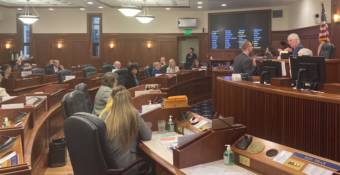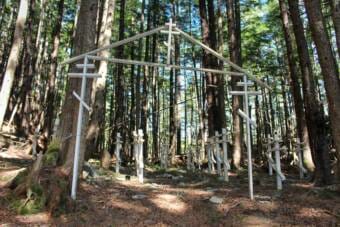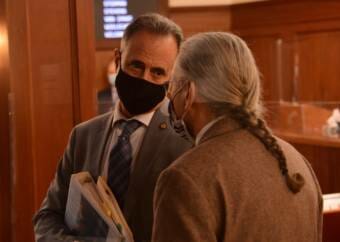
How much will Alaskans receive in permanent fund dividends this year? As the Legislature works its way through the annual budget process, the answer to that question is once again unclear. A new factor shaping the debate this year is the large amount of federal money coming into the state.
Alaska’s legislators will have to decide whether to pay the roughly $3,000 dividends proposed by Republican Gov. Mike Dunleavy using the formula in state law, or a smaller amount. Over the past five years, they’ve ranged from a low of $992 in 2020 to a high of $1,606 in 2019.
Nome Democratic Rep. Neal Foster noted at a March 18 news conference that paying a smaller number than Dunleavy proposed would help maintain the Alaska Permanent Fund’s earnings reserve. Money from the reserve pays for both dividends and state government services.
“We’ve got a lot of folks in our caucus that want the smaller, reasonable PFD,” he said. “They don’t want to jeopardize the ability to pay PFDs in the future. They don’t want to potentially impact our schools and our roads and our public safety down the road.”
But Foster said there’s another view within the House majority caucus.
“There are other folks who support the full PFD,” he said. “They say, ‘If there’s any time, you know, to support one, now’s the time, during a global pandemic.”
Until early March, it looked like the state would have to draw more than was planned from the permanent fund’s earnings reserve to pay for any PFD.
However, Congress recently passed the American Rescue Plan Act, which includes more than $1 billion that the state government can spend, as well as more than $300 million for Alaska schools. That money could be used to pay for the state budget. And that would allow room for the state to pay dividends.
Foster said this money could help — but he doesn’t want it to be used to avoid making hard choices about the dividend.
“We can’t allow this federal money coming in right now to be an excuse for us to continue to kick the can down the road,” he said. “We’ve already done that for a few years now.”
The federal money isn’t the only thing that could help create room in the budget to pay for dividends. Rising oil prices led the state to increase the amount it forecasts to receive in revenue this year and next by nearly $800 million.
Foster and other lawmakers hope to forge an agreement on a bigger goal than just this year’s dividend. They’re looking to make a permanent change to the formula in state law. That hasn’t happened since the state stopped following the original formula five years ago.
Dunleavy has proposed putting PFDs in the state constitution, as part of an amendment that would outline rules for the overall annual draw from the fund.
Leaders of both the state House and the Senate have expressed optimism that the state can pass a new formula for dividends this year.
Soldotna Republican Senate President Peter Micciche said it will be necessary that any new dividend formula both helps pay for state government and meets the expectations of Alaskans. He says now is the time to do it.
“Because if you don’t do it this year, next year’s an election year,” he said. “If you think that the Legislature has been ineffective on any forward motion on this in the last five years. Without any action this year, they will continue that trend on an election year.”
That’s a challenge because finding a way to pay for dividends beyond this year would require broader agreements on issues that divide Alaskans — and the state’s leaders. Those include whether to cut state services much more deeply as Dunleavy proposed two years ago, introduce a broad tax like a statewide income or sales tax, and whether to increase the taxes paid by oil companies.
Resolving these differences has proven to be a stubborn problem, between a conservative Republican governor, a mostly Republican Senate majority that has sometimes differed with him on policy, and a mostly Democratic House majority.
Anchorage Democratic Rep. Ivy Spohnholz is among those searching for a potential long-term solution, as the chair of the new House Special Committee on Ways and Means.
“We’re going to look at everything,” she said. “We’re going to look at ways to cap the growth of government, spend our resources more wisely, and we’re going to look at new revenue because we need to make meaningful progress.”
For this year, it’s not yet clear exactly how the state can spend the American Rescue Plan money. The federal government is scheduled to release guidelines on May 10. That won’t leave much time for the Legislature to pass a plan for the money before May 19, the constitutional deadline to end the session.



